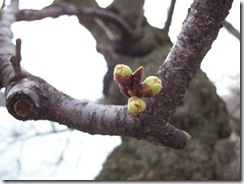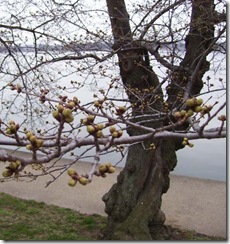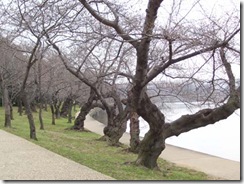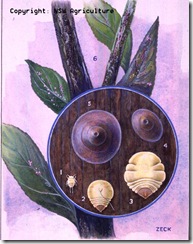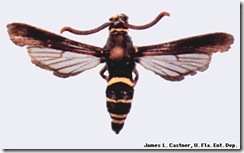« The Electronic Ax Man | Main | Cherry Blossom Gems »
March 16, 2009
Marching Toward the Equinox
From Ron Paci
Craftsman at Large
Say hello to L129, and one of its second stage buds.
.......and L133.
And the rest of the venerable Yoshinos who have been on duty for 90 plus years here at the northwest corner of the Tidal Basin, formerly a swamp, here in the nation's capitol. The trees are numbered. That's L139 in the foreground with the big Y.
Each year the blossoms of the 3,700 or so trees around the Tidal Basin create one of the city's biggest traffic jams. They are in the background of family photographs in homes around the world.
For two years, when I worked near Capitol Hill, I rode my bicycle around the Jefferson Memorial side of the Tidal Basin and watched the blossoms from bud to bloom. Some years I missed them completely. This year I'm going to watch them close-up.
----------------------------------------------------------
Usually on a bleak daylight deprived January day, Louis Halle comes down from his place in my bookcase, and wanders around the house. Sometimes he's in the kitchen. Sometimes on the shelf by my bed. Some evenings, in the living room. He moves around a lot as we compare notes on our Spring watches.
In 1945, Louis decided he was going to be the official observer of Spring in Washington and he wrote a book by that name. From January to June he rode his bicycle from his apartment in Woodley 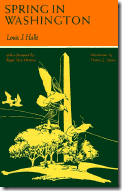 Park near Connecticut Avenue to work at the State Department. He took the long way. Sometimes a 5 or 6 mile long way; then back again to his office on Constitution Avenue.
Park near Connecticut Avenue to work at the State Department. He took the long way. Sometimes a 5 or 6 mile long way; then back again to his office on Constitution Avenue.
His year, forever captured, is well known in the birding community. The birds he saw that Spring were the focal point of his observations. Roger Tory Peterson was here that year too, and wrote the forward in my copy of the book. Most years some journalist will make a note of it in the local papers. The older book stores know right where he's kept.
"Every morning now is fresh wonder, no two quite the same. Thursday, March 1, a cloudless day, the west wind blowing easily across the city. By the time the sun rises now, about a quarter to eight, I am likely to be across the bridge and into Virginia, having myself arisen in the starlight....All the birds are sparkling and ebullient in the sharp dawn. A redwing at the top of a tree is singing...Three grackles are clucking and grating to one another in the thicket. This is life beginning....emerging from the darkness and damp into the new day. It is spring in microcosm."
Louis skips over March 2, the day my father was killed in Germany.
He picks up again on Saturday, the 3rd. On a ride around the Tidal Basin, he notes: for the first time, the Robins are vocal.
I learned from him that the first note spring is actually heard in January, when, after weeks of cold, and avian silence, one morning the singing begins. I heard it this year. The Sparrows woke me; a few days later the first Cardinal call.
Louis had a big mind. A sensitive mind. I think the years of war drove him to his self-appointed task; he just couldn't take it any more; he turned to nature: "To snatch the passing moment and examine it for signs of eternity is the noblest of occupations......Therefore I undertook to be monitor of the Washington seasons, when the government was not looking."
As the season unfolds he sees an amazing variety of birds, including a couple bobwhites on Constitution Avenue. One Saturday, he rides 20 miles to Mount Vernon. He follows arrival of the warblers, and ends the first week in June after a little over 200 pages with his last sighting of a warbler for the season, a Blackpoll, behind the Japanese embassy. On nearly every page are words to live by.
He never describes his bicycle; though, in one of the many drawings in the book there is a bicycle with drop handlebars and a derailleur gear change mechanism. Very advanced, and probably rare in the U. S., in 1945.
Over the course of his life he wrote about 22 books on various subjects spiraling upward into an ivory tower, surely away from the crowd, judging by the density of his 1977 book Out of Chaos. It is a 646 page tome of everything he knew, and could find out, about everything. He called it "an exercise in perspective." He said all his life he tried to keep an eye on all basic knowledge, and in this book he lines it all up from quantum physics, through cell biology, evolution, ancient history, and more, onto music. He wrote it when he was in his mid-60's, after his retirement as a professor at the Graduate Institute of International Studies in Geneva, where he went after he left the State Department in 1967.
He died in 1998 at 87. He had Alzheimer's.
---------------------------------------------------------------
The Yoshino cherry trees of the Tidal Basin had a hell of a time getting started. It was 'Big Bill' Taft's wife Nellie, who finally made it happen. She learned about things Asian when Taft was governor-general of the Philippine Islands, now ours, in 1900-03. Asia was happening in those years; American artists and architects were using Japanese and Chinese motifs.
After years of lobbying by several people, some spending their own money, to get official Washington to use the dramatic flowering cherry trees on streets and parks, it took Nellie's interest to finally get them here; in 1910, the first boat load of 2,000, a gift from the mayor of Tokyo, arrived.
Unfortunately, they had a frightening degree of infestation, and after a lot of fretting, President Taft finally caved in to the recommendation of USDA scientist/inspectors, and ordered them burned, despite the tears of his wife and others.
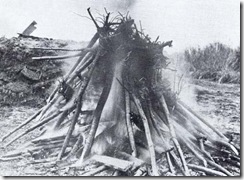 We'll just say 'they fell off the boat...' NPS photo
We'll just say 'they fell off the boat...' NPS photo
That incident, commonly reported in the cherry tree history, had some far reaching implications. Over 70 percent of the trees were contaminated with root gall worm; 45 percent showed evidence of crown gall; other unpleasant visitors included San Jose scale, Sesiid moth, weevil, canker worm, and, my favorite: black thrips.
Sesiid moth bores and feeds
San Jose scale: insect grows a
shell and feeds beneath. Can suck a tree dry.
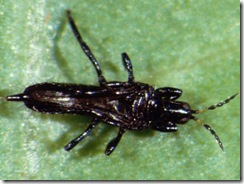 Mr. Black Thrips eats stems and leaves
Mr. Black Thrips eats stems and leaves
There were no quarantine regulations at the time. One of the USDA scientists involved in the inspection was Nathan Cobb, who came to be known as the father of nematology. His statement about the event led to the passing of the first Plant Quarantine Act in 1912.

NPS photo of the inspection
The whole thing was a diplomatic nightmare. Somebody suggested reporting to the mayor of Tokyo that they fell off the boat. After tiptoeing around the matter, another batch arrived in 1912; this time 3,000 in number, and thoroughly fumigated.
Their average life span is 40 years, but through propagation and grafting from the originals, the population has been maintained. Many of the originals from the first planting are still scattered around the edge of the water, kept alive beyond all expectations by constant care. Though, there have been losses from time to time.
A few days after Pearl Harbor, somebody cut down four of the trees; and for the remainder of the war they were referred to as 'Oriental flowering cherry trees.'
In 1999, beavers made an appearance, and started causing trouble.
Predicting exact day the famous ring of trees will blossom has eluded planners of the annual festival since the first big one in 1934. The trees have their own formula to decide the exact day: the length of the day plus the minutes of sunlight times the average rainfall from Feb. 20-March 20 divided by the number of minutes of over 60 degrees in temperature times the square root of the minutes of southerly wind over 30 days plus the speed divided by the number of minutes under 45 degrees of temperature, and the rest of the formula is pure speculation.
The blossoms rarely last more than a few days, a wabi sabi metaphor of the brevity of life itself: Now you see them, now you don't. Like Louis says: "For a few ticks I am here, uncomprehending, attempting to make some record or memorial of this eternal passage, like a traveler taking notes in a strange country....."
In the coming days I will attempt to record the march from buds to blossoms on cherry trees 129, 133 and their neighbors, the closest trees to my favorite stealthy, but illegal parking spot.
Posted by ronpaci at March 16, 2009 5:15 PM
